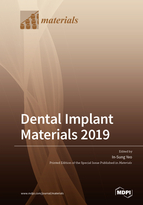Dental Implant Materials 2019
A special issue of Materials (ISSN 1996-1944). This special issue belongs to the section "Biomaterials".
Deadline for manuscript submissions: closed (31 May 2020) | Viewed by 50981
Special Issue Editor
Interests: biologic interfaces; implant–abutment connection; applied physics
Special Issues, Collections and Topics in MDPI journals
Special Issue Information
Dear Colleagues,
Dental implant materials are advancing in the fusion of various scientific fields. Surface modification technologies for implants have begun to be applied to titanium at the micro-level for about four decades. Now, implant surfaces are being topographically and chemically modified at the micro- and at nano-levels. The modification techniques are altering other metals and ceramics, making these materials more biocompatible. Materials for abutments in dental implant systems appear to depend on implant–abutment connection structures. Biomechanical factors like friction and preload influence the development of the abutment materials. Also, the surfaces of the abutment materials are important in the soft tissue attachment, which is being actively investigated. Because dental implants have to be functional in human bodies for a long time, numerous materials are being clinically tested as implant-supported restorations.
This Special Issue, “Dental Implant Materials 2019”, aims to collect the creative works of scientists on the current advancements in the field of materials for implant dentistry. Biologic or biomechanical responses to materials related to dental implants are more than welcome in this Special Issue. In vivo results and the clinical interpretation of the properties of the materials are particularly emphasized. However, other aspects regarding the dental implant materials are also included.
Assoc. Prof. In-Sung Yeo
Guest Editor
Manuscript Submission Information
Manuscripts should be submitted online at www.mdpi.com by registering and logging in to this website. Once you are registered, click here to go to the submission form. Manuscripts can be submitted until the deadline. All submissions that pass pre-check are peer-reviewed. Accepted papers will be published continuously in the journal (as soon as accepted) and will be listed together on the special issue website. Research articles, review articles as well as short communications are invited. For planned papers, a title and short abstract (about 100 words) can be sent to the Editorial Office for announcement on this website.
Submitted manuscripts should not have been published previously, nor be under consideration for publication elsewhere (except conference proceedings papers). All manuscripts are thoroughly refereed through a single-blind peer-review process. A guide for authors and other relevant information for submission of manuscripts is available on the Instructions for Authors page. Materials is an international peer-reviewed open access semimonthly journal published by MDPI.
Please visit the Instructions for Authors page before submitting a manuscript. The Article Processing Charge (APC) for publication in this open access journal is 2600 CHF (Swiss Francs). Submitted papers should be well formatted and use good English. Authors may use MDPI's English editing service prior to publication or during author revisions.
Keywords
- bone-implant interface
- soft tissue-implant interface
- implant-abutment connection
- implant-supported prosthodontic materials
- biocompatibility
- biomechanics







